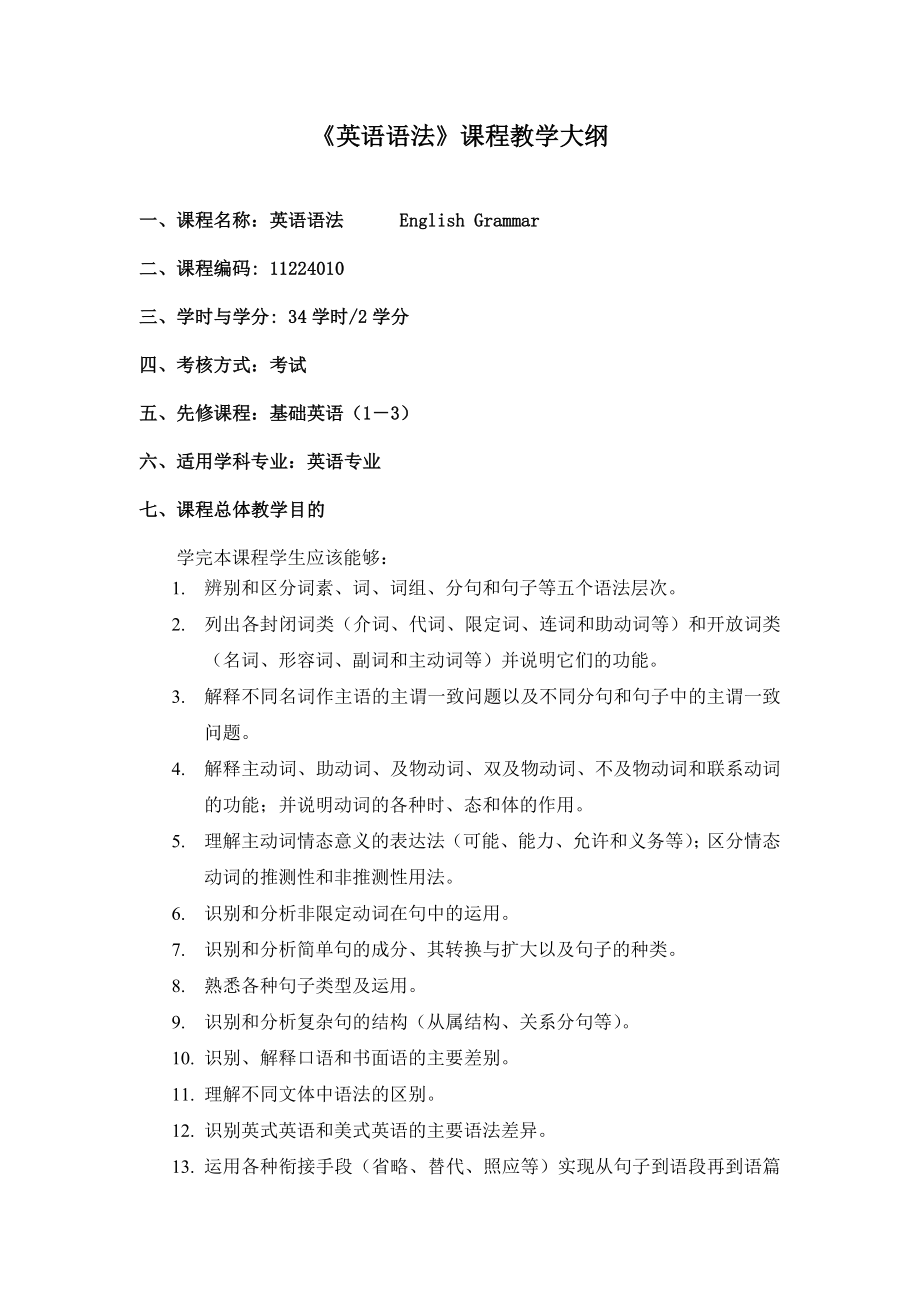 英语语法课程教学大纲(精品)
英语语法课程教学大纲(精品)



《英语语法课程教学大纲(精品)》由会员分享,可在线阅读,更多相关《英语语法课程教学大纲(精品)(9页珍藏版)》请在装配图网上搜索。
1、英语语法课程教学大纲一、课程名称:英语语法 English Grammar二、课程编码: 11224010三、学时与学分: 34学时/2学分四、考核方式:考试五、先修课程:基础英语(13)六、适用学科专业:英语专业七、课程总体教学目的 学完本课程学生应该能够:1. 辨别和区分词素、词、词组、分句和句子等五个语法层次。2. 列出各封闭词类(介词、代词、限定词、连词和助动词等)和开放词类(名词、形容词、副词和主动词等)并说明它们的功能。3. 解释不同名词作主语的主谓一致问题以及不同分句和句子中的主谓一致问题。4. 解释主动词、助动词、及物动词、双及物动词、不及物动词和联系动词的功能;并说明动词的各
2、种时、态和体的作用。5. 理解主动词情态意义的表达法(可能、能力、允许和义务等);区分情态动词的推测性和非推测性用法。6. 识别和分析非限定动词在句中的运用。7. 识别和分析简单句的成分、其转换与扩大以及句子的种类。8. 熟悉各种句子类型及运用。9. 识别和分析复杂句的结构(从属结构、关系分句等)。10. 识别、解释口语和书面语的主要差别。11. 理解不同文体中语法的区别。12. 识别英式英语和美式英语的主要语法差异。13. 运用各种衔接手段(省略、替代、照应等)实现从句子到语段再到语篇的连贯性和逻辑性。八、总体教学要求:英语语法是英语专业的专业必修课,使用教材为章振邦编著的新编英语语法教程,
3、由上海外语教育出版社出版。该课程帮助学生比较系统地了解分析英语语法的方法,使他们认识、了解英语口语和书面语的区别以及从词到句再至语篇的构造。通过对各个语法层次,即词素、词、词组、分句和句子的系统认识和分析,提高学生使用英语的规范性以及传递信息、表达思想的准确性和逻辑性。由于学生在中学阶段已经了解、掌握了相当的语法知识,本课程不求面面俱到,而是有所侧重。通过一学期的学习,本课程旨在进一步提高学生实际运用英语的能力,为后来的学习和研究英语语言、文学奠定基础。讲授之前对学生进行测试以便确定教学的重点,其他的由学生自己学习掌握,教师会通过练习检测学生的学习情况。除了教材上的练习(课堂上做一部分;布置课
4、后做一部分;其余学生自行处理),学生要完成的作业还包括课后的写作、翻译、课堂上的小组讨论、相互改错等活动,通过对语法知识的实际运用促进他们对英语语言结构的理解和掌握。所有课内、课外作业和小组活动的参与各占平时成绩的一半比分。平时成绩占总成绩的30%。期末考试为笔试,除了对语法点的测试,着重考核学生对知识理解和运用,此类测试所占比例一般不少于50%。九、基本教学安排本课程开设一个学期,总学时为34学时,每周2个学时,安排在第4个学期。教学进度安排如下:Unit 1: Introduction Grammatical HierarchyObjectives Define Sentence, Cla
5、use, Phrase, Word and Morpheme. Segment a full sentence rank by rank down to morphemes. Distinguish different types of sentences.Grammatical hierarchy Morphemes Words Phrases Clauses SentencesMain point: Sentence typesHomework: Write a journal about two pages, double space. Topic free.Unit 2: Senten
6、ce StructureObjectives Identify different clause elements in a sentence. Identify different clause types. Combine simple sentences into a single compound, complex or compound-complex sentence.Sentence structure Clause elements Basic clause types and their transformation and expansionMain point: the
7、combination of sentences.Homework Exercise 1C , p24-27. Reading assignment, p 28-51 on subject-verb concord.Unit 3: Nouns, Genitive Nouns and PronounsObjectives Apply a basic knowledge of nouns, genitive nouns and pronouns. Identify major types of nouns. Distinguish between types of pronoun.Nouns, G
8、enitive Nouns and Pronouns Classification of nouns and function of noun phrases Number forms of nouns Partitives Independent genitive and double genitive Pronoun concord and case forms Types of pronounMain points: number forms of nouns; pronoun concord and case formsHomework: Ex. 4C, p67; Ex. 5D, p8
9、1-82; Ex. 9C, p155-156.Practice 1The focuses of each practice class depend on the common mistakes made by the students in their previous exercises. The class is designed for the teacher to give feedbacks and for the students to do more exercises to help them try to avoid similar errors in the future
10、.Unit 4: DeterminersObjectives Apply a basic knowledge of determiners and quantifiers as word classes to the analysis of their sentence functions. Distinguish between the functions of central, pre- and post-determiners.Determiners Collocations between determiners and nouns Collocations between deter
11、miners A comparative study of some determiner usage Articles in use with different classes of nounMain points: Collocations between determiners; Articles in useHomework: Ex. 6E, p95-96.Unit 5: Adjective and Adjective PhraseObjectives Identify the formation of adjectives and the syntactic roles they
12、play in sentences. Apply multi-adjective modifiers in a correct order. Identify and use adjectives as postmodifiers. Distinguish dynamic adjectives from stative adjectives, gradable adjectives from non-gradable adjectives so as to use them correctly.Adjective and Adjective Phrase Classification and
13、formation of adjectivesl Pure adjectivesl Adjectives from nounsl Adjectives from verbsl Adjectives from present participlesl Adjectives from past participlesl Compound adjectives Adjectives in usel Syntactic functionsl Order of multi premodifiersl Postmodifying adjectivesl Adjective phrasesl Dynamic
14、 and stative adjectivesl Gradable and non-gradable adjectivesl Confusing adjectivesMain points: syntactic functions, especially the predicative and attributive roles of adjectivesHomework: Ex. 23A, 11-40, p390-391; 23C, p396-397.Unit 6: Adverb and Adverb PhraseObjectives Identify the formation and c
15、lassification of adverbs Identify the syntactic roles of adverbs Apply a basic knowledge of the position of adverbs in sentences for clarity.Adverb and Adverb Phrase Formation of adverbsl Simple adverbsl Compound adverbsl Adverbs derived by suffixationl Fixed phrases Classification of adverbs Adverb
16、s in usel Syntactic rolesl Positions in sentencesl Adverbs with the same form as adjectivesl Adverbs with and without -lyMain point: positions in sentenceHomework: Ex. 24A, p411-412; Ex. 24D, p421-422; reading assignment, p423-437 on comparison and comparative constructions.Practice 2Unit 7: Verbs (
17、I) Overview Objectives Identify different types of verbs. Explain the functions of main, auxiliary, transitive, ditransitive, intransitive and linking verbs.Verbs Overview Verb types and their functionsl Main verbsl Auxiliary verbsl Linking verbs Tense, aspect, voice and moodMain point: ditransitive
18、 verbsHomework: Ex. 10A, p165.Unit 8: Verbs (II) Tense and AspectObjectives Demonstrate an understanding of how the verb phrase is marked differentially to represent present and past actions, processes and states. Show how the phenomenon of aspect is used to convey perfect and progressive meanings v
19、ia the verb phrase.Tense and Aspect Uses of simple present and simple past Uses of present progressive and past progressive Uses of present and past perfective (progressive)Main points: simple present and past; present progressiveHomework: A report from each group on what the students discuss in cla
20、ssUnit 9: Means of Referring to Future Time and Passive VoiceObjectives Explain the ways in which future time is referred to. Explain the cohesive and pragmatic roles played by the passive voice in discourse.Referring to future time Constructions denoting future time Means of referring to future tim
21、ePassive voice Active and passive sentence Passive voice of non-finite verbs Roles played by the passive voice in discourseMain points: difference of the ways referring future time; roles of the passive voiceHomework: Ex. 13C, p235-236; Ex. 15A, p255; Ex. 15C, p263-264.Practice 3Unit 10: Subjunctive
22、 Mood and Non-finite verbsObjectives Understand ways of expressing hypothetical meanings. Identify the roles non-finite verbs play in sentences.Subjunctive mood BE-subjunctive WERE-subjunctive Other forms of subjunctiveNon-finite verbs Infinitive -ing participle -ed participleMain point: roles of in
23、finites in sentencesHomework: a paper from each group on If I were; Ex. 22D, p385-386; reading assignment, p281-321 on auxiliary verbs.Unit 11: Analyzing Sentences (I)Objectives Identify and analyze existential sentences, It-patterns and conditional sentences.Analyzing sentences Existential sentence
24、s It-patterns Conditional sentencesMain points: verbs in existential sentences; conditional sentencesHomework: reading assignment, p440-466 on preposition and prepositional phrase; p467-487 on statement, question, command and exclamation.Unit 12: Analyzing Sentences (II)Objectives Identify and analy
25、ze coordination and subordination. Identity and analyze reduced relative clauses.Analyzing sentences Coordination Subordination Relative clausesMain points: dangling modifiers; absolute constructionHomework: Ex. 30 A, p508-509; Ex. 32F, p558; Ex. 33D, p585-589.Unit 13: From Sentence to TextObjective
26、s Understand and apply cohesive devices to improve cohesiveness of written texts.Cohesive devices Substitution Ellipsis Reference ConjunctionMain points: all cohesive devicesHomework: Ex. 40E, p716-718; Ex. 40F, p718-720.Practice 4附录1:教学课时分配表单元(U)/练习课(P)教学内容教学时数备注讲授作业作业时数未包括课内练习U1语法导论21U2句子结构22U3名词、
27、名词属格和代词21P1学生作业常犯错误反馈、练习2U4限定词21U5形容词和形容词词组21U6副词和副词词组22P2学生作业常犯错误反馈、练习2U7动词(I)21U8动词(II)22U9将来时间表示法、被动语态22P3学生常犯错误反馈、练习2U10虚拟语气、非限定动词22U11句子分析(I)22U12句子分析(II)22U13从句到篇22P4学生常犯错误反馈、练习2合计3420附录2:主要参考书目1、Douglas Biber等编著:朗文英语口语和笔语语法,外语教学与研究出版社2000年版。2、A. J. Thomson等编著:牛津实用英语语法,第四版,外语教学与研究出版社2006年版。3、琼平卡姆编著:中式英语之鉴,外语教育与研究出版社2007年版。4、Analyzing English Grammer,香港公开大学翻译系语法教材。5、汪福祥编著:语法与语用,外文出版社2006年版。6、吴艾玲编著:多功能系统英语语法,国防工业出版社2006年版。
- 温馨提示:
1: 本站所有资源如无特殊说明,都需要本地电脑安装OFFICE2007和PDF阅读器。图纸软件为CAD,CAXA,PROE,UG,SolidWorks等.压缩文件请下载最新的WinRAR软件解压。
2: 本站的文档不包含任何第三方提供的附件图纸等,如果需要附件,请联系上传者。文件的所有权益归上传用户所有。
3.本站RAR压缩包中若带图纸,网页内容里面会有图纸预览,若没有图纸预览就没有图纸。
4. 未经权益所有人同意不得将文件中的内容挪作商业或盈利用途。
5. 装配图网仅提供信息存储空间,仅对用户上传内容的表现方式做保护处理,对用户上传分享的文档内容本身不做任何修改或编辑,并不能对任何下载内容负责。
6. 下载文件中如有侵权或不适当内容,请与我们联系,我们立即纠正。
7. 本站不保证下载资源的准确性、安全性和完整性, 同时也不承担用户因使用这些下载资源对自己和他人造成任何形式的伤害或损失。
